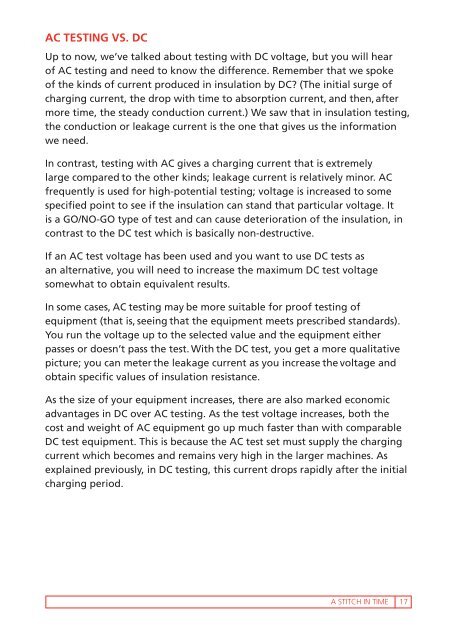“A Stitch in Time...”
Create successful ePaper yourself
Turn your PDF publications into a flip-book with our unique Google optimized e-Paper software.
AC Test<strong>in</strong>g vs. DC<br />
Up to now, we’ve talked about test<strong>in</strong>g with DC voltage, but you will hear<br />
of AC test<strong>in</strong>g and need to know the difference. Remember that we spoke<br />
of the k<strong>in</strong>ds of current produced <strong>in</strong> <strong>in</strong>sulation by DC? (The <strong>in</strong>itial surge of<br />
charg<strong>in</strong>g current, the drop with time to absorption current, and then, after<br />
more time, the steady conduction current.) We saw that <strong>in</strong> <strong>in</strong>sulation test<strong>in</strong>g,<br />
the conduction or leakage current is the one that gives us the <strong>in</strong>formation<br />
we need.<br />
In contrast, test<strong>in</strong>g with AC gives a charg<strong>in</strong>g current that is extremely<br />
large compared to the other k<strong>in</strong>ds; leakage current is relatively m<strong>in</strong>or. AC<br />
frequently is used for high-potential test<strong>in</strong>g; voltage is <strong>in</strong>creased to some<br />
specified po<strong>in</strong>t to see if the <strong>in</strong>sulation can stand that particular voltage. It<br />
is a GO/NO-GO type of test and can cause deterioration of the <strong>in</strong>sulation, <strong>in</strong><br />
contrast to the DC test which is basically non-destructive.<br />
If an AC test voltage has been used and you want to use DC tests as<br />
an alternative, you will need to <strong>in</strong>crease the maximum DC test voltage<br />
somewhat to obta<strong>in</strong> equivalent results.<br />
In some cases, AC test<strong>in</strong>g may be more suitable for proof test<strong>in</strong>g of<br />
equipment (that is, see<strong>in</strong>g that the equipment meets prescribed standards).<br />
You run the voltage up to the selected value and the equipment either<br />
passes or doesn’t pass the test. With the DC test, you get a more qualitative<br />
picture; you can meter the leakage current as you <strong>in</strong>crease the voltage and<br />
obta<strong>in</strong> specific values of <strong>in</strong>sulation resistance.<br />
As the size of your equipment <strong>in</strong>creases, there are also marked economic<br />
advantages <strong>in</strong> DC over AC test<strong>in</strong>g. As the test voltage <strong>in</strong>creases, both the<br />
cost and weight of AC equipment go up much faster than with comparable<br />
DC test equipment. This is because the AC test set must supply the charg<strong>in</strong>g<br />
current which becomes and rema<strong>in</strong>s very high <strong>in</strong> the larger mach<strong>in</strong>es. As<br />
expla<strong>in</strong>ed previously, <strong>in</strong> DC test<strong>in</strong>g, this current drops rapidly after the <strong>in</strong>itial<br />
charg<strong>in</strong>g period.<br />
A STITCH IN TIME 17



